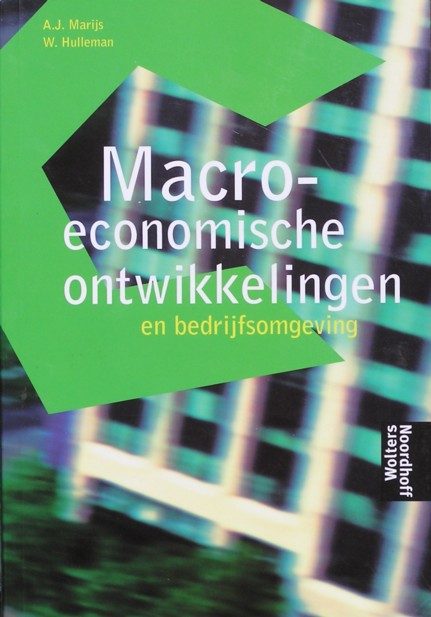

Following the book Micro-economie your reviewer again selects an introductory textbook, namely Macro-economische ontwikkelingen en bedrijfsomgeving by A.J. Marijs and W. Hulleman. No more than Micro-economie can Macro-economische ontwikkelingen en bedrijfsomgeving claim any originality. But the book does describe clearly and without pranks the structure of the Dutch economy, and that is worth something. In fact, those who like to be original, must first learn what is normal1. That question rose already eight years ago, when your reviewer got hooked on books like Economics: an introduction to traditional and radical views. So much criticism of what is, spontaneously creates the desire to have a second opinion. It is time to set to work2.
So that led to the book Macro-economische ontwikkelingen en bedrijfsomgeving. Incidentally Marijs and Hulleman are a creative pair of authors, that has published already several books3. The books aim at college students, and therefore prefer a strictly practical approach. The authors give clear definitions and explanations of the essential economic variables, and illustrate these with many graphs, statistics, and tables. Marijs and Hulleman remain local, and take all their data from the Dutch economy. Indeed their book is not just material for students, but also interesting for the average reader of newspapers. The Het Financieele Dagblad is even an often cited source ("the better journals", the publisher states perkily on the back cover)4.
The authors add schemes and figures, where needed. In the marge headwords are printed, so that the reader is not obliged to use his own marker. Here and there cases are added, as well as control questions (are you still alert, reader?5). All definitions are repeated in a list at the end of each chapter. In short, the book provides for a foundation, that allows to build on with confidence. The whole outlay is didacticly sound to such an extent, that it is almost American. Undoubtedly other Dutch publishers offer similar textbooks, but your reviewer had not met one, that surpasses Macro-economische ontwikkelingen en bedrijfsomgeving.
What then are those data, that are so valuable and necessary for the interested layman? The book begins with a story about the role of the enterprise in the economic production. In the following chapter the economic cycle is explained, so including consumption. Besides, the entrepreneurial functions such as investing and exporting are explained. The examples show that the Netherlands is indeed highly dependent on the foreign trade. And since the contents concern macro-economics, the reader gets acquainted with mysterious terms (for everybody with the exception of the subscribers to Het Financieele Dagblad) such as "balance of the current account" and the "macro-economic explorations" (the MEV).
Next the Dutch income distribution is analyzed. Besides, the Dutch citizen disposes of access to all kinds of collective services, and the authors include that theme at the same time. The causes behind the distribution of wagework is studied in- depth. Moreover, the secundary income (benefits) and teriary income (subsidies and the like) are addressed. But here one also finds intriguing subjects such as the distribution of wealth. On the other hand, the income of the state itself is discussed, so that he can fulfil his task of redistribution. Indeed, the taxes. Much of this information is contained in the MEV. These turn out to present informations as mutations, which is unusual. Is this a heritage of Tinbergen?
It is logical that now the structure of the Dutch economy must be described. The book indeed addresses this subject, albeit merely at the end. Then the reader is supplied with an impressive table of the complete Dutch economy, including employment. A distinction is made between the shopkeepers and small entrepreneurs and the big industries, which is of course fascinating material for adherents of concentration theories. Besides, the investments, innovations and export are again analyzed. The reader gets acquainted with essential variables, such as the capital intensity (including a table) and the investment quote.
In five chapters and roughly hundred pages the economic dynamics is discussed. It is obvious that here the growth is most important, but the conjuncture is also addressed and even the inflation. For instance, here an interesting table about the composition of the price index is presented. The conjuncture is a strange phenomenon, which is ill understood and the subject of wild speculations. This book merely presents a birds's-eye view of the theme. It is interesting that apparently some enterprises invest in an anti-cyclical manner (see p.286), which is clever, because it requires the prediction of the future.
The structural growth is evidently also studied in detail. Growth originates from investments, and so requires capital. Therefore the money circulation is treated here, albeit very superficially. Those who want to know more, must consult other books of Hulleman and Marijs. The subject of growth covers fascinating themes, such as the development of labour productivity. Indeed again a table is supplied, unfortunately again expressed as mutations. Furthermore, here the reader is finally informed about the Dutch propensity to save. An important variable is the capital coefficient, which shows the quantity of capital, that the Dutch need in order to earn their living. Here some remarks are also made about durability, albeit scantily. Actually the durable development is a rather multi-disciplinary theme (just like for instance well-being or ethics).